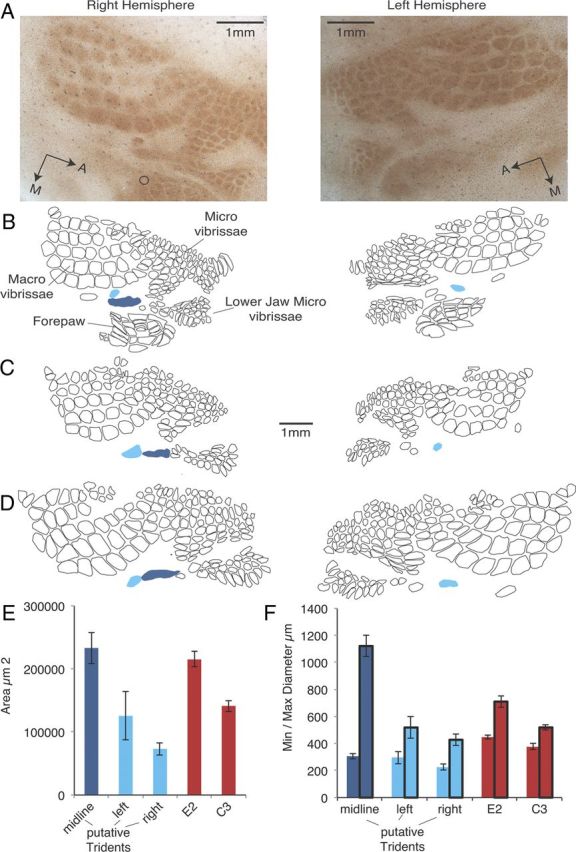Figure 5.

Identification of putative trident barrels in flattened barrel cortices. A, Micrographs of flattened right and left somatosensory cortices of a rat histochemically stained for cytochrome-oxidase activity. Dark brown indicates zones of heightened (metabolic) cytochrome-oxidase activity, thus revealing whisker and paw barrels. Sections showing the putative trident barrel most clearly were chosen (highlighted in color in the drawings below); nevertheless these barrels are less clearly defined than the adjacent facial barrels. B, Camera lucida drawing of shapes of whisker and forepaw barrels from the brain shown in A. Note that the drawing is based on several serial sections (in addition to the one shown above) and is shown at a reduced scale. The drawing is slightly rotated such that the anterior–posterior body axis runs horizontally. The putative trident barrels are shown as filled shapes in light blue (left and right trident) and dark blue (midline trident). Putative trident barrels were uniquely identified on the basis of the following four criteria: (1) the coordinates estimated from physiology and the map of Chapin and Lin (1984), (2) extracellular mapping of receptive fields combined with histology, (3) their topographic location in the face representation, (4) the larger size of trident whiskers and the assumed larger size of trident barrels compared with the adjacent posterior lower jaw whisker barrels, and (5) their number (n = 3). C, D, Two further barrel drawings of pairs of left and right somatosensory cortices. These drawings are restricted to whisker barrels; paw barrels are not shown. Other conventions are as in B. E, Areas of trident barrels and the facial barrels E2 (the largest facial barrel) and C3 (an average size facial barrel). F, Minimal and maximal (with black border) Feret diameter of trident and facial barrels. The Feret diameter is the shortest/longest border-to-border line crossing the shape's center. Data in E and F refer to flattened barrel cortices from 10 hemispheres of five animals resulting in five trident barrels each and 10 E2, C3 barrels from both hemispheres. Because cortices were flattened, absolute area and diameter estimates might be overestimates. Error bars indicate SEM.
